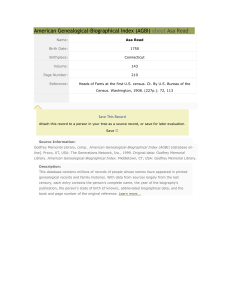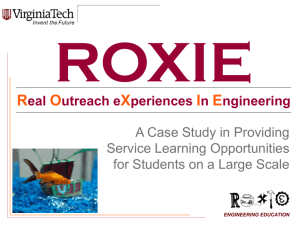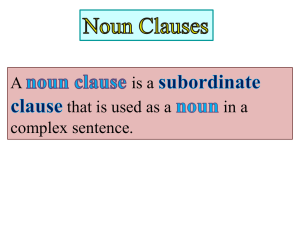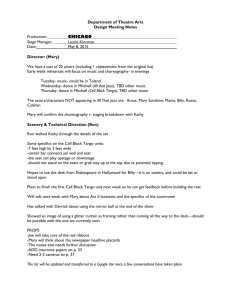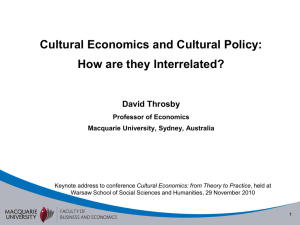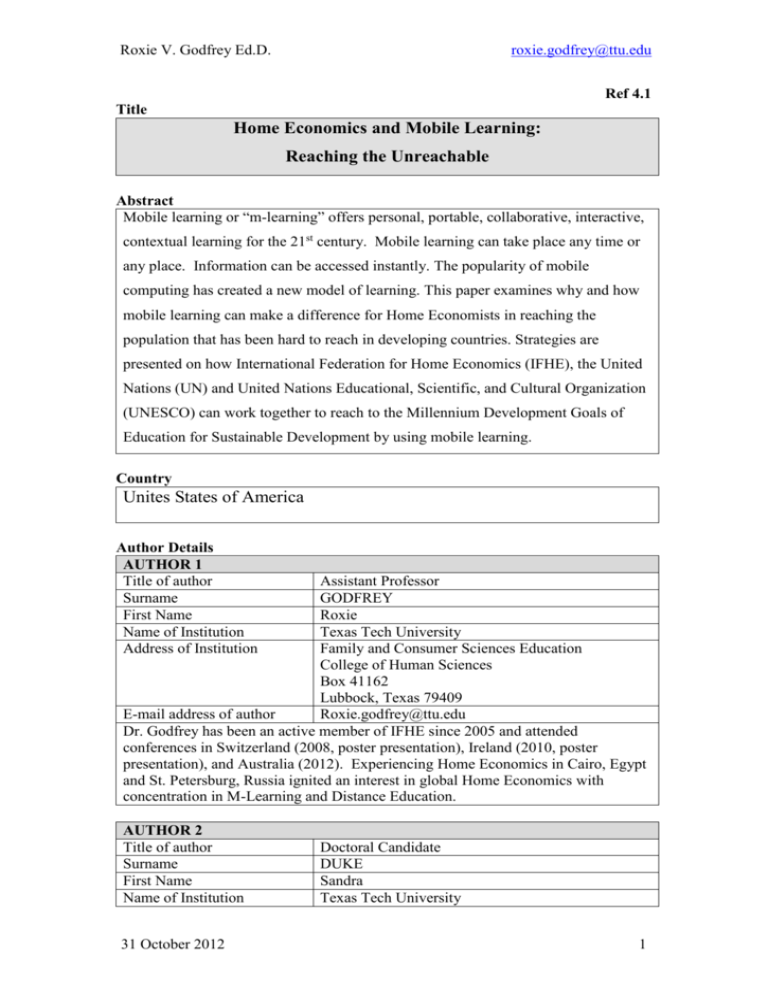
Roxie V. Godfrey Ed.D.
roxie.godfrey@ttu.edu
Ref 4.1
Title
Home Economics and Mobile Learning:
Reaching the Unreachable
Abstract
Mobile learning or “m-learning” offers personal, portable, collaborative, interactive,
contextual learning for the 21st century. Mobile learning can take place any time or
any place. Information can be accessed instantly. The popularity of mobile
computing has created a new model of learning. This paper examines why and how
mobile learning can make a difference for Home Economists in reaching the
population that has been hard to reach in developing countries. Strategies are
presented on how International Federation for Home Economics (IFHE), the United
Nations (UN) and United Nations Educational, Scientific, and Cultural Organization
(UNESCO) can work together to reach to the Millennium Development Goals of
Education for Sustainable Development by using mobile learning.
Country
Unites States of America
Author Details
AUTHOR 1
Title of author
Surname
First Name
Name of Institution
Address of Institution
Assistant Professor
GODFREY
Roxie
Texas Tech University
Family and Consumer Sciences Education
College of Human Sciences
Box 41162
Lubbock, Texas 79409
E-mail address of author
Roxie.godfrey@ttu.edu
Dr. Godfrey has been an active member of IFHE since 2005 and attended
conferences in Switzerland (2008, poster presentation), Ireland (2010, poster
presentation), and Australia (2012). Experiencing Home Economics in Cairo, Egypt
and St. Petersburg, Russia ignited an interest in global Home Economics with
concentration in M-Learning and Distance Education.
AUTHOR 2
Title of author
Surname
First Name
Name of Institution
31 October 2012
Doctoral Candidate
DUKE
Sandra
Texas Tech University
1
Roxie V. Godfrey Ed.D.
roxie.godfrey@ttu.edu
Address of Institution
Family and Consumer Sciences Education
College of Human Sciences
Box 41162
Lubbock, Texas 79409
E-mail address of author
Sandra.duke@ttu.edu
Ms. Duke is a doctoral candidate in Family and Consumer Sciences Education at
Texas Tech University with research interests in diverse cultures and mobile
technologies. Her background is in Cooperative Extension Service Education and
entrepreneurship.
CATEGORIES
Citizenship
Consumer
Education
THEMES
Cultural Diversity
Environment
Gender Equity
Health Promotion
Home Economics
Political
Sustainable Development
Sustainable Consumption
Sustainable Development
Sustainable Urbanisation
UN Decade of Education for
Sustainable Development
UN Millennium Development
Goals
Peace & Human Security
Rural Development
TYPE
Case Study
Discussion Paper
Illustrated Story with
photographs
Philosophical Reflection
31 October 2012
Research Paper
Teacher Resource
Other (Please state)
2
Roxie V. Godfrey Ed.D.
roxie.godfrey@ttu.edu
Home Economics and Mobile Learning:
Reaching the Unreachable
Abstract
Mobile learning or “m-learning” offers personal, portable, collaborative, interactive,
contextual learning for the 21st century. Mobile learning can take place any time or
any place. Information can be accessed instantly. The popularity of mobile
technologies has created a new model of learning. This paper examines why and how
mobile learning can make a difference for Home Economists in reaching the
population that has been hard to reach in developing countries. Strategies are
presented on how International Federation for Home Economics (IFHE), the United
Nations (UN) and United Nations Educational, Scientific, and Cultural Organization
(UNESCO) can work together to reach to the Millennium Development Goals of
Education for Sustainable Development by using mobile learning.
Introduction
What is the role of Home Economics in preparing the consumer citizen for the
challenges of sustainable development? Home Economics (Family and Consumer
Sciences, in the United States) was founded on principles of resource management;
sound nutrition and food safety; human development and growth; and community
action. The challenge that faces the profession today, as in the past, is to educate the
uneducated and reach the unreachable through the use of science and technology to
meet the everyday needs of individuals and families. Mobile technologies are
indispensable tools which will have an immense effect on 21st century education. In
2002, Keegan anticipated, “mobile learning is a harbinger of the future of learning”
(p. 9, cited in Park, 2011, Introduction).
Mobile learning (m-learning) is educational content delivered through mobile devices.
Nicky Hockly, director of pedagogy of The Consultants-E explains, “Mobile learning
is not just about mobile phones (or ‘cellphones’). Tablet computers (such as the iPad),
pocket computers (such as the Apple® iTouch), small laptops (often called netbooks),
e-readers (devices which allow you to read electronic books), MP3 players (for audio)
31 October 2012
3
Roxie V. Godfrey Ed.D.
roxie.godfrey@ttu.edu
and MP4 players (for video) – even handheld gaming devices – are all potential
mLearning devices” (Clandfield, 2012, Section 1).
A 2009 report from Canada’s Athabasca University makes the following bold claim:
“Mobile learning, through the use of mobile technology, will allow citizens of the
world to access learning materials and information from anywhere and at any time.
Learners will not have to wait for a certain time to learn or go to a certain place to
learn. With mobile learning, learners will be empowered since they can learn
whenever and wherever they want” (Clandfield, 2012, Section 1).
Mobile technology is helping to resolve limitations of education in access and
personalization. M-learning solutions illustrate the power of mobile technology in
addressing some of the specific challenges affecting the quality and effectiveness of
education for learners. Many theories of education have been instrumental in
developing mobile learning materials (Naismith et al., 2006), but despite the many
forms and increasing use of mobile learning, it is still immature in terms of its
technological limitations and pedagogical considerations (Traxler, 2007).
Research
Surprisingly, the majority of mobile phone users can be found in Cairo and Calcutta
rather than New York and Paris. Mobile phone coverage in developing nations is
spreading rapidly due to greater affordability and improved hardware. The devices
that were once only accessible to the wealthy are now available to the poor. In Africa,
the continent with the lowest mobile distribution, a majority of people already own
them, and those who do not own them are buying them as fast as they can. “Access to
robust mobile networks is nearly universal: 90% of the world’s population and an
impressive 80% of the population living in rural areas are blanketed by a mobile
network. This means that learners who might not have access to high-quality
education or even schools often do have working mobile phones” (UNESCO, 2012a,
p. 6).
Global Systems for Mobile Communication Association (GSMA), an association for
mobile operators representing the interest of digital technologies, collaborates with
major corporations and has introduced global initiatives to aid developing countries.
One partnership is GSMA mWomen, which promotes continued research into
31 October 2012
4
Roxie V. Godfrey Ed.D.
roxie.godfrey@ttu.edu
women’s issues such as equality, health, and human development. GSMA conducted
the first global study in 2006 to identify women’s mobile usage in low and middle
income countries. This study revealed that by extending the benefits of mobile phone
ownership to women, a host of social and economic goals can be advanced such as
safety, independence, and increased income potential. Focusing on women and giving
them ownership of mobile technology has a prevailing impact on improving lives and
livelihoods. Additional benefits include supporting women’s literacy and girls’
education, advancing access to health education, and expanding about economic
opportunities (GSMA, 2012a).
Two key obstacles to women’s mobile phone ownership and use were identified in the
study as: cost of ownership and perceived lack of need for mobile phones by women.
GSMA has been instrumental in providing handsets and cellular service in many low
and middle income countries. Home Economists are in a prime position to assist in
developing educational content for delivery via mobile phones that can increase the
attractiveness of the units and thus provide these women with the additional benefits
of safety and independence.
Internet World Stats reports up-to-date world Internet usage and population statistics
for over 233 individual countries. The latest data, found in table 1, indicates that
Africa, the Middle East, and Latin America/Caribbean have the largest growth in
internet usage since 2000.
Table 1: WORLD INTERNET USAGE AND POPULATION STATISTICS
June 30, 2012
World Regions
Africa
Asia
Europe
Middle East
North America
Latin America /
Caribbean
Oceania / Australia
WORLD TOTAL
Population
( 2012 Est.)
1,073,380,925
3,922,066,987
816,372,817
223,608,203
348,280,154
592,994,842
Internet
Users
Dec. 31, 2000
4,514,400
114,304,000
105,096,093
3,284,800
108,096,800
18,068,919
35,815,913
7,012,519,841
7,620,480
360,985,492
Internet Users
Latest Data
167,335,676
1,076,681,059
518,512,109
90,000,455
273,785,413
254,915,884
Penetration
(%)
Population)
15.6 %
27.5 %
63.5 %
40.2 %
78.6 %
43.0 %
24,279,579
2,405,510,175
67.8 %
34.3 %
Growth
2000-2012
Users %
of Table
3,606.7 %
841.9 %
393.4 %
2,639.9 %
153.3 %
1,310.8 %
7.0 %
44.8 %
21.5 %
3.7 %
11.4 %
10.6 %
218.6 %
566.4 %
1.0 %
100.0 %
NOTES: (1) Internet Usage and World Population Statistics are for June 30, 2012. (2) CLICK on each world region name for detailed regional
usage information. (3) Demographic (Population) numbers are based on data from the US Census Bureau and local census agencies. (4) Internet
usage information comes from data published by Nielsen Online, by the International Telecommunications Union, by GfK, local ICT Regulators
and other reliable sources. (5) For definitions, disclaimers, and navigation help, please refer to the Site Surfing Guide. (6) Information in this site
may be cited, giving the due credit to www.internetworldstats.com. Copyright © 2001 - 2012, Miniwatts Marketing Group. All rights reserved
worldwide.
Source: Internet World Stats http://www.internetworldstats.com/stats.htm
31 October 2012
5
Roxie V. Godfrey Ed.D.
roxie.godfrey@ttu.edu
“GSMA’s Wireless Intelligence predicts that the mobile industry will reach the five
billion user milestone over the next decade as network expansion continues to
progress in developing markets and as people in rural areas, many of whom currently
live on less than $2 a day, will subscribe to mobile service” (GSMA, 2012b).
Research conducted by Gill et al., (2010) for the International Center for Research on
Women (ICRW), reported that the “potential to advance women economically may be
the most exciting transformative feature of technology”. Their evidence confirmed
GSMA’s findings that access to mobile technology improves women’s economic
status and produces positive results for children, families, and society.
Building on the research by Gill et al. (2010), there are numerous ways Home
Economists can contribute to m-learning initiatives.
Create a website for mobile access, including content on the various stages of
human development and a chat feature with experts in child development.
Develop regular SMS text reminders about vaccination schedules and other
health related issues.
Utilize podcasts for entrepreneurial skill development.
Update and digitize Home Economics textbooks
United Nations Millennium Development Goals
In 2000, the United Nation world leaders met in New York at the United Nations
Headquarters to adopt the United Nations Millennium Declaration, a platform for
leaders to commit their nations to a new global partnership to reduce extreme poverty
by setting “Millennium Development Goals” (UN MDG) to be reached by 2015.
Besides reducing poverty, seven additional goals were set which included stopping
the spread of HIV/AIDS, and providing education for sustainable development (IFHE,
2011).
According to United Nations Secretary-General, Ban Ki-Moon, much progress has
been made in the 10 plus years since the United Nations Millennium Declaration was
adopted.
31 October 2012
6
Roxie V. Godfrey Ed.D.
roxie.godfrey@ttu.edu
Already, the MDGs have helped to lift millions of people out of poverty,
saved lives and ensure that children attend school….At the same time, the
report shows that we still have a long way to go in empowering women and
girls, promoting sustainable development, and protecting the most vulnerable
from the devastating effects of multiple crises, be they conflicts, natural
disasters or volatility in prices for food and energy (United Nations, 2011,
p. 3).
Home Economists are amply equipped to address these pressing needs. Mobile
learning and its vast tools are increasingly available to the even the poorest and most
needy in the world and through concerted and organized efforts Home Economists
can fill the gaps with valuable knowledge to empower women and girls, promote
sustainable development, and protect the vulnerable.
International Federation for Home Economics
The International Federation for Home Economics (IFHE) serves as a platform for
international exchange within the field of Home Economics and is the only worldwide
organization concerned with Home Economics and Consumer Studies. IFHE’s
ultimate goal is to improve the quality of everyday life for individuals, families and
households through the management of their resources. IFHE also promotes human
rights and universal values of households and families and has consultative status with
the United Nations and with the Council of Europe.
The Position Statements UN Millennium Development Goals 2011 brochure
produced by IFHE reveals ways Home Economists can support the UN Millennium
Campaign. Education for sustainability development gives every human being the
right to acquire the knowledge, skills, attitudes, and values necessary to shape a
sustainable future (IFHE, 2011, p. 25). Home Economists can develop and deliver
m-learning resources to low and middle income countries which will help the people
to be better consumers, producers, and citizens for the 21st century.
United Nations Educational, Scientific, and Cultural Organization
United Nations Educational, Scientific, and Cultural Organization (UNESCO) is the
United Nations agency dedicated to the 2005 – 2014 Decade of Education for
31 October 2012
7
Roxie V. Godfrey Ed.D.
roxie.godfrey@ttu.edu
Sustainable Development. “The broad goals and concrete objectives of the
international community – as set out in the internationally agreed development goals,
including the Millennium Development Goals (MDG) – underpin all UNESCOs
strategies and activities” (UNESCO, 2012).
The four major educational priorities supported by UNESCO are:
Improving access to quality basic education,
Reorienting existing education programs,
Developing public understanding and awareness, and
Provide training (IFHE, 2011, p. 26).
The UN MDGs, IFHE, and UNESCO’s educational priorities are tied with the
common thread of “helping people to develop the attitudes, skills and knowledge to
make informed decisions for the benefit of themselves and others, now and in the
future, and to act upon these decisions” (IFHE, 2011, p. 24).
The Future is Now
M-learning is emerging as one of the solutions to the challenges faced by citizens
served through UNESCO, IFHE, and United Nations MDGs. UNESCO believes that
mobile technologies can expand and enrich education opportunities for students in
diverse contexts. “A growing body of evidence suggests that ubiquitous mobile
devices— mobile phones in particular—are being used by students and teachers
around the world to access information, streamline administration, and facilitate
learning in new and innovative ways” (UNESCO, 2012b, p. 2). The prospect of
having all pertinent information accessible at a given moment in real time has led to
the rapid development of the wireless communication system and demands for a lowcost mobile wireless device, especially mobile phones (Fetaji, 2008, p.1). M-learning
rests at the intersection of online learning and mobile computing (Yordanova, 2007).
Home Economics education provides many integrated resources to improve the
quality of life for individuals and families and contributes to efforts to end poverty
and its associated maladies (IFHE, 2011). Home Economists can use mobile
31 October 2012
8
Roxie V. Godfrey Ed.D.
roxie.godfrey@ttu.edu
technologies as a vehicle to extend educational opportunities by developing mlearning content material for low income populations to receive at the kitchen table, in
the field, at the bus stop, any time anywhere.
Imagine this:
A woman in Pakistan improves her newly acquired literacy skills by text
chatting with a Home Economist at the university as she learns more about
entrepreneurship.
A young girl in Cairo, Egypt practices math skills as she uses the calculator on
her cell phone to double a recipe.
Home Economics textbooks, continually up-to-date, digitized, and displayed
on a mobile device saving students and schools monetary resources.
A group of girls in South Africa compete in friendly interactive games on their
mobile devices as they learn about food safety and sanitation, measurements,
cooking terms, or financial literacy.
M-learning holds the potential to assist individuals who have historically been
deficient in educational opportunities. What can you imagine?
M-learning is using mobile devices to provide a way of accessing educational content
with the ability to build an extensive learning community. Whereas infrastructure and
accessibility to other technology is limited in developing countries, mobile technology
is pervasive and offers opportunities for educators to reach out to those previously
unreachable and for the individuals, women in particular, to take advantage of
educational opportunities that will benefit them and their families. Many countries
already have efforts underway to ensure that mobile devices are used safely and
effectively to enhance students’ educational experiences rather than detract from
them.
M-learning can help bridge the education gender divide that is more pronounced in
developing countries by providing a safe learning environment for females without
having to leave the household or communities (GSMA, 2012c).
31 October 2012
9
Roxie V. Godfrey Ed.D.
roxie.godfrey@ttu.edu
Conclusion
“As mobile technology continues to make inroads in education it will be necessary
for policy-makers to ensure that programmes help rectify educational inequities and
bridge, rather than widen the digital divide” (UNESCO, 2012a, p. 7). UNESCO calls
for partnerships to be developed which will create beneficial and constructive impacts
on educational decisions being made for the 21st century. Home Economists, in
education, business, government, and leadership, are poised for action and armed with
knowledge to forge partnerships, which can reach the unreachable through mobile
technologies.
The future is here! Home Economists’ open to endless possibilities, will advance
m-learning as it revolutionizes the way individuals, families, and communities learn.
31 October 2012
10
Roxie V. Godfrey Ed.D.
roxie.godfrey@ttu.edu
References
Clandfield, L., 2012. Global mLearning sessions.[Kindle Fire version]. McMillian
Education.
Fetaji, M., 2008. Literature review of M-Learning issues: M-learning projects and
technologies. In C. Bonk, et al. eds. 2008. Proceedings of World Conference on ELearning in Corporate, Government, Healthcare, and Higher Education. Chesapeake,
VA: AACE. Available at: http://www.editlib.org/p/29628 [Accessed 26 September
2012].
Gill, K., Brooks, K., McDougall, J., Patel, P, Kes, A., 2010. Bridging the gender
divide: How technology can advance women economically [online]. Available at:
http://www.icrw.org/publications/bridging/bridging-gender-divide [Accessed 20
October 2012]
GSMA, 2012a.Mobilink reshaping education in the lives of women and girls in rural
areas through mobile technology [online]. Available at:
http://www.mwomen.org/News/mobilink-reshaping-education-in-the-lives-ofwomen-and-girls-in-rural-areas-through-mobile-technolo [Accessed 5 September
2012].
GSMA, 2012b. GSMA announces new global research that highlights significant
growth opportunity for the mobile industry.[online]. Available at:
http://www.gsma.com/newsroom/gsma/gsma-announces-new-global-research-thathighlights significant-growth-opportunity-for-the-mobile-industry [Accessed 25
October 2012].
GSMA, 2012c. Portraits: A glimpse into the lives of Base of the Pyramid women
[online]. Available at: http://www.mwomen.org/Research/portraits-a-glimpse-intothe-lives-of-base-of-the-Pyramid-women [Accessed 11 September 2012].
IFHE, 2011. Position statements UN millennium development goals. Bonn:
International Federation of Home Economics.
Internet World Stats, 2012. Usage and population statistics.[online], Available at:
http://www.internetworldstats.com/stats.htm [Accessed 30 October 2012]
Naismith, L., Lonsdale, P., Vavoula, G., Sharples, M., 2006. Literature review in
mobile technologies and learning. [pdf] Available at
https://lra.le.ac.uk/jspui/bitstream/2381/813
2/4/%5B08%5DMobile_Review%5B1%5D.pdf [Accessed 18 September 2012].
Park, Y., 2011. A pedagogical framework for mobile learning: Categorizing
educational applications of mobile technologies into four types. The International
Review of Research in Open and Distance Learning [e-journal] 12(2). Available at:
www.irrodl.org/index.php/irrodl/article/view/791/1699 [Accessed 10 September,
2012].
Traxler, J., 2007. Defining, discussing, and evaluating mobile learning. International
Review of Research in Open and Distance Learning, 8(2). Available at
http://www.irrodl.org/index/php/ irrodl/article/view/346 [Accessed 18 September
2012].
31 October 2012
11
Roxie V. Godfrey Ed.D.
roxie.godfrey@ttu.edu
UNESCO, 2012a. Turning on mobile learning: Global themes. UNESCO Working
Papers Series on Mobile Learning. Available at:
http://unesdoc.unesco.org/images/0021/002164/216451e.pdf [Accessed 25 September
2012].
UNESCO, 2012b. Mobile learning policies: Keys issues to consider [online].
Available at http://unesdoc.unesco.org/images/0021/002176/217638e.pdf [Accessed
on 12 October 2012]
United Nations, 2011. The millennium development goals report. New York: United
Nations.
Yordanova, K., 2007. Mobile learning and integration of advanced technologies in
education, in B. Rachev, A. Smrikarov, & D. Dimov eds. 2007. Proceedings of ACM
International Conference on Computer Systems and Technologies, vol. 285, Sofia,
NY: AMC. Available at: http://dl.acm.org/citation.cfm?id=1330695 [Accessed 25
September 2012]
31 October 2012
12

